House Oversight and Government Reform Committee Hearing
Wednesday, May 11, 2016
Written Testimony
Good Morning Mr. Chairman, Ranking Member Cummings and Members of the Committee. Thank you, Chairman Chaffetz, for calling this hearing, to discuss the need for timely and comprehensive postal reform legislation.
The United States Postal Service provides the nation with a vital delivery platform that sustains and propels American commerce, serves every American business and residential address, and binds the nation together, as it has for more than 240 years.
We currently deliver to more than 155 million delivery points. The 154 billion pieces of mail we deliver annually account for 47 percent of the world’s mail, which we deliver at levels of efficiency and affordability equal to or exceeding any comparable post. And we do so without the financial support of the American taxpayer; the Postal Service is a self-funding entity that derives its revenues entirely through the sale of postal products and services.
Even in an increasingly digital world, the Postal Service remains an essential part of the bedrock infrastructure of the economy. The physical delivery of mail and packages to America’s homes and businesses is the core function of the Postal Service, and this fundamental need of the American people will exist for the foreseeable future.
Our customers place great faith in the ability of the Postal Service to deliver for them, both in the literal delivery of mail and packages, and in the larger sense as an organization that is adapting and changing to better meet America’s evolving delivery needs.
The Postal Service is speeding the pace of innovation, improving our competitive posture by offering new products, and pursuing large-scale efforts to lower our cost base and stabilize our systemic financial imbalances. And we’re doing so against a backdrop of great change in technology use and consumer habits, and of rapidly rising expectations for delivery services.
However, our ability to continually change and improve to meet the evolving needs of the American economy and society depends upon our ability to operate with a financially sustainable business model. My testimony today describes our current financial situation and argues for legislation that would provide the Postal Service with the financial stability to invest in our future and continue to be an engine of growth, to be a strong business partner, to compete for customers with compelling new services and offerings, and to meet the expectations of the American public.
The timing of this hearing is notable. We are now entering the 10th year since the enactment of the Postal Accountability and Enhancement Act of 2006 (PAEA). At the time the PAEA was enacted, we had just finished fiscal year 2006, in which we delivered 213 billion pieces of mail; last year, we delivered 154 billion pieces, a 28 percent decline. Unfortunately, the PAEA did not establish a business model with sufficient flexibility to enable us to effectively respond to this unanticipated precipitous volume decline.
Rather, as a result of this law, the Postal Service is subject to statutory and regulatory constraints that make it impossible to maintain financial stability while achieving our primary mission of providing prompt, reliable and efficient postal services and meeting our other legal obligations. The PAEA imposed an inflexible price cap that has proven to be completely unsuitable in an environment characterized by declining mail volumes — particularly in First-Class Mail, which provides the greatest contribution to covering our institutional costs, including the costs associated with the ever-expanding number of U.S. delivery addresses.
In addition to having limited ability to generate revenues under the price cap, we have limited ability under the PAEA and other laws that place obligations on us to control our major cost drivers, such as our network costs and our pension and retiree health care benefits. The Postal Service is required to maintain an extensive network necessary to process and deliver the mail to every address six days a week. The cost of that network is largely fixed or growing, regardless of volume. However, less volume and limited pricing flexibility means that there is less revenue to pay for that network. In addition, the PAEA imposed a major burden on us through its accelerated schedule for prefunding our retiree health care benefits liability. While this schedule may have been considered manageable at the time the PAEA was enacted, volume trends and revenue impact since that time have upended that belief. Since our available borrowing authority has been exhausted, we have been forced to default on those payments over the past several years in order to meet our universal service obligation.
During the last decade, we have responded aggressively to the challenges that confronted us. For example, we have rationalized our operations in response to the sharp decline in mail volume, increased workforce flexibility, and established a more affordable wage system. These efforts have resulted in costs savings of approximately $15 billion annually. We also are proud of our achievements in significantly growing our package business, and implementing innovations that have enhanced the value of the mail to better serve our customers.
Despite these achievements, our efforts have not been enough — and cannot be enough — to restore the Postal Service to financial health, absent legislative and regulatory reform. Our debt is at an unsustainable level and while we continue to pursue available management actions to reduce our costs even further, there are limited remaining initiatives within our control that will result in substantial cost savings without threatening our ability to continue to provide prompt, reliable, and efficient postal services. The $5.1 billion net loss for 2015 represents the ninth consecutive annual net loss the Postal Service has incurred. We have reached our borrowing limit and have a cash reserve that is wholly inadequate for an organization of our size.
In fact, we have maintained adequate liquidity to continue achieving our primary mission of providing universal postal services only by defaulting on our legally mandated retiree health benefits (RHB) payments and by deferring needed capital investments. While the fixed RHB payment schedule ends this year, we are then obligated to make RHB normal cost payments averaging approximately $3.3 billion per year and to begin amortizing our unfunded RHB liability at an annual cost of approximately $3 billion per year, for a total cost of $6.3 billion per year.
Furthermore, beginning next fiscal year we are also obligated to begin amortizing our unfunded liability in the Civil Service Retirement System (CSRS), which will require an annual payment of $1.5 billion. These obligations are in addition to another sizable existing prefunding payment — normal cost payments under the Federal Employees’ Retirement System (FERS) — of approximately $3.4 billion per year (average through 2020), and amortization payments on an unfunded FERS liability of more than $200 million per year (though we do not believe that FERS is truly underfunded if our liability was more appropriately calculated, and have therefore requested that the Office of Personnel Management [OPM] reconsider this amortization amount). This yields total average annual payments of $11.4 billion per year through 2020. Therefore, while we benefit from the fact that the obligation to pay for the premiums for current annuitants will shift to the Postal Service Retiree Health Benefits Fund (PSRHBF) next year, we will still be subject to very sizable prefunding payments going forward, on top of our other operating expenses and a need to begin increasing capital expenditures on items such as our information technology infrastructure, our processing and delivery infrastructure and, most importantly, new delivery vehicles.
Absent fundamental legislative and regulatory reform, we face the prospect of having to continue to default on certain of these prefunding payments in order to continue paying our employees and suppliers and to provide postal services to the American public. This increases the risk that taxpayers may ultimately be called on to fund these benefits. For instance, a failure to make the actuarially-based RHB payments moving forward would reduce and eventually exhaust the balance in the PSRHBF, because that Fund will be used to pay premiums for current annuitants beginning next year. Once the Fund is exhausted, which could occur in as short as a decade, the obligation to pay those premiums would return to the Postal Service, at a time when we will have less volume and therefore less ability to cover any such obligation.
Therefore, it is clear that simply defaulting on our prefunding obligations is not a feasible strategy for success. Rather, we need a statutory andregulatory structure that allows us to take steps to raise revenue and cut costs in a rational, business-like manner, so that we can fulfill our responsibility of providing universal service in a self-sufficient manner while also covering our post-retirement benefits obligations. This requires two steps: the enactment by Congress of appropriate postal reform legislation, and a favorable resolution by the Postal Regulatory Commission (PRC) of the upcoming review of the ratemaking system.
We recognize that meaningful postal reform legislation will impact our many constituents in different ways. For that reason, we have been working over the last year with key stakeholders, including our labor unions and a cross-section of the mailing industry, to discuss the business model issues that confront us, and to identify potential key statutory reforms capable of achieving broad support that would make the Postal Service more sustainable. In formulating our legislative proposal, we had numerous discussions with stakeholders to understand their interests and concerns and to explain ours. Based upon these discussions, we propose a set of focused provisions, which, if enacted into law by Congress, would make substantial progress towards restoring the Postal Service to financial health.
The provisions we are recommending, and which are described below, reflect the adoption of many private sector best practices while maintaining our public responsibilities. Our proposal would:
- Require full Medicare integration for parts A, B and D, for postal retiree health plans;
- Restore our exigent price increase for market-dominant products;
- Calculate all retirement benefit liabilities using postal-specific salary growth and demographic assumptions; and
- Provide some additional product flexibility.
This proposal, along with other management initiatives, will achieve approximately $32 billion in savings through 2020. (See the chart on page 16 for a detailed explanation.)
While enactment of our proposal is a critical step towards restoring the Postal Service to financial health, it is not a sufficient step by itself. We expect total mail volumes to continue to decline, particularly in First-Class Mail, due to the existence of electronic alternatives. The Postal Service will maintain a sharp focus on achieving operational savings where possible, consistent with our service obligations and the other constraints of law. Also of critical importance is the review of the current ratemaking system, and its replacement with a regulatory structure that enables us to effectively respond to the challenges and opportunities presented by a dynamic marketplace. The current cap has failed because it limits price increases simply on the basis of household inflation, without regard to the Postal Service’s unique circumstances. The PRC has an opportunity beginning in December to review and replace that system with a suitable regulatory structure.
Considering its importance, the PRC must conduct the review in a timely manner, and for that reason we were disappointed that the PRC recently rejected our request to simply clarify whether the price cap, along with other aspects of the current pricing system, will be a part of the review. Addressing preliminary issues now would have ensured that the substantive aspects of the review — whether the current system is achieving the statutory objectives, and if not, how it should be replaced — could have proceeded efficiently. It also would have allowed all stakeholders, including the Postal Service and Congress, to have a clear understanding about the scope of the review. Resolving this issue now is clearly within the PRC’s statutory authority, and would in no way require it to make preliminary conclusions about, or otherwise prejudge, the substantive outcome of the review.
While replacement of the current price cap with an appropriate regulatory structure is ultimately going to be necessary in any event, Congressional action on our proposal would minimize the size of the price increases needed to cover our costs.
Overall, our financial situation is very serious but solvable; we can return to financial stability through the enactment of prudent legislative reform and a favorable resolution of the 10-year regulatory review. We will at the same time continue to pursue cost savings in all aspects of our operations, and revenue growth where it is available, particularly in packages. These steps will allow appropriate investment in the future of the organization, so that we can continue to provide prompt, reliable and efficient delivery service to the American public.
The mailing industry continues to help power our nation’s economy. The Postal Service plays an indispensable role as a driver of commerce and a provider of delivery services to all communities. The need to adopt these legislative reforms is simply too important to delay any further.
POSTAL SERVICE FINANCIAL CONDITION
In the fiscal years 2007 through 2015, due to digital diversion and the proliferation of Internet and mobile-based communications and exacerbated by the Great Recession, total mail volume has declined by approximately 27 percent and First-Class Mail, our most profitable product, has declined by 35 percent. The annual value of the revenue lost as a result of the total volume decline is $21 billion per year. The decline in total mail volume, as well as the shift in the mail mix to a greater percentage of lower-margin products, has a pernicious impact on our financial stability. It reduces the amount of contribution available to pay for the significant percentage of costs that do not vary with volume, but are a result of the nationwide retail, processing, transportation, and delivery network that we are required to maintain in order to provide universal service.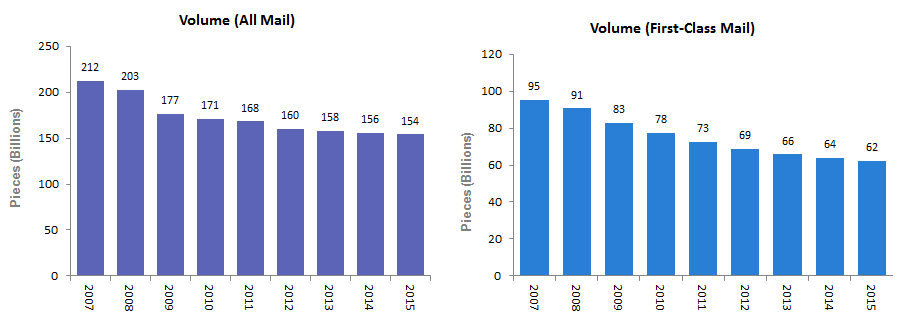
The declines in revenue are driven primarily by the lower First-Class Mail volume noted above. Although the significant growth in our package business has been encouraging, the reality is that we would need package volume to increase by 249 percent in order to make up for the loss of contribution resulting from historical volume losses of First-Class Mail.
For fiscal year 2015, the Postal Service incurred a net loss of $5.1 billion, and has incurred cumulative net losses of $56.8 billion from 2007 to 2015. These financial losses are at unsustainable levels.
Nine Years of Net Losses Despite Innovation and Improved Efficiency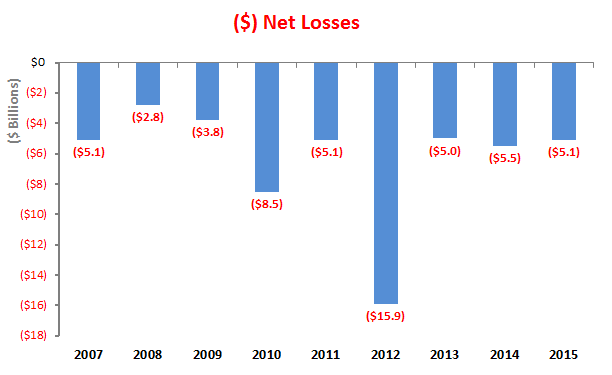
As a result of these losses, we do not have sufficient cash balances to meet all of our existing legal obligations, pay down our debt, and maintain a responsible level of liquidity. We have been forced to default on our RHB prefunding retirement obligation since 2012 and we reached our $15 billion borrowing capacity under our statutory debt ceiling that same year. We would not have been able to pay our employees and suppliers, or to deliver the mail, without these defaults, our deferred capital investments, and our aggressive management actions. Our cash balance remains insufficient to support an organization with approximately $74 billion in annual operating expenses, and with liabilities that exceed assets by $90 billion, under the actuarial funding method.
Total Liabilities, Including Retirement Obligations Exceed Assets by $90 Billion
- This chart includes all assets and liabilities of pension and post-retirement health benefits obligations.
- Items highlighted in yellow are not shown on our balance sheet and the RHB obligations are valued under actuarial funding basis as of Sept. 30, 2015.
Furthermore, in order to continue meeting our statutory obligation to provide prompt, reliable and efficient postal services to the nation, our operations will require significant capital investment over the next few years. Investments are needed to sustain, modernize and improve our information technology infrastructure, and our processing and delivery infrastructure, including our aging fleet of vehicles. Over the past several years, we have deferred all but essential capital investments in order to maintain our liquidity. The cumulative amount of deferred or reduced investment from 2009 through 2016 amounts to over $8.5 billion. While this was a necessary short-term response to our financial situation, the continued deferral of investment can no longer be maintained.
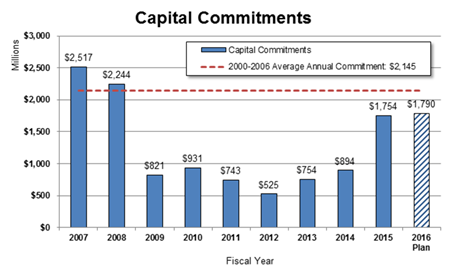
Investments in our infrastructure are needed to meet our universal service obligation and to fully and efficiently capitalize on business opportunities in the growing package delivery market. Our delivery fleet includes approximately 140,000 vehicles that are at least 20 years old and are at or near the end of their useful lives. Repair and maintenance costs for these vehicles have risen significantly in recent years and this situation is unsustainable.
OPERATIONAL ACTIVITIES
We have responded aggressively to the loss of 58 billion pieces of mail (27 percent of total volume) from 2007 to 2015 by rationalizing our business to fit the current and projected mail and package volume. At the same time, our delivery points continued to increase by more than 900,000 each year, necessitating adjustments and flexibility in operations. Since the beginning of 2007, we have made tough, fiscally responsible decisions and managed operational costs within our control. These actions have included:
- Reducing our career employee complement by more than 200,000, without resorting to layoffs;
- Negotiating with our unions on wages, benefits and workforce flexibility;
- Reducing work hours by 331 million;
- Consolidating more than 20,000 delivery routes and operations at 360 facilities;
- Modifying retail operation hours in approximately 13,000 Post Offices to better align with customer demand;
- Reducing the number of administrative areas from nine to seven and districts from 80 to 67, and;
- Significantly decreasing headquarters spending.
These actions have allowed us to reduce our annual cost base by almost $15 billion. At the same time, we have improved efficiency for six consecutive years. However, these and other actions have not been enough to restore us to financial health.
PRODUCT ENHANCEMENTS
As a part of our efforts to adjust to the dynamic marketplace, we are changing and improving to better serve our customers through continued innovation and improved efficiency. We have also focused our efforts on developing new products and enhancing existing product offerings to meet the needs of an ever-evolving marketplace. We have concentrated on providing new services to enhance the value of mail to our customers, growing e-commerce and implementing marketing campaigns to grow our package business.
Our package volume has grown by more than 1 billion packages in the last three years. In FY 2015, we delivered one-third of all domestic packages in the United States. To spur additional growth in our package business, we are partnering with a number of major U.S. retailers to develop customized delivery solutions to meet their particular business needs. Examples of the solutions we have developed include our Sunday, grocery, and same-day delivery initiatives, as well as our “ship-from-store” agreements that expedite the delivery of goods from businesses to consumers and improve convenience. These efforts have significantly enhanced the continued double-digit growth in package volume.
Continued innovation and growth in our package business is essential to our ability to provide universal postal service to the American people as First-Class Mail continues to decline. These products provide an essential — and growing — level of contribution to help us pay for our institutional costs, and thus help to sustain the network that benefits all mailers. However, the expected growth in package volumes and revenues is not enough to make up for the massive loss of mail volume and revenue that used to be available to pay for our network costs.
PROPOSAL
Stabilizing the Postal Service’s financial condition will require continued management initiatives and a comprehensive approach to improve both innovation and efficiency. Moving forward, we will continue to contain costs, and speed the pace of product and service innovation. All of these actions will unfortunately not be enough to stave off future losses and stabilize our finances. Legislative reform is required now, and the proposal set forth below, along with other changes, such as a favorable outcome in the 10-year regulatory review, makes our financial situation eminently solvable.
Over the past year we have been working with key stakeholders, including our labor unions and a cross-section of the mailing industry, to try to identify key reforms that would return the Postal Service to financial health and also be acceptable to as many of those stakeholders as possible. The legislation the Postal Service is seeking should include the following provisions:
- Requiring full Medicare integration for parts A, B, and D for postal retiree health plans;
- Restoring our exigent price increase for market-dominant products;
- Calculating all retirement benefit liabilities using postal-specific salary growth and demographic assumptions; and
- Providing some additional product flexibility.
With legislation enacted that includes these provisions, the Postal Service can achieve an estimated $32 billion in combined cost reductions and new revenue over the next five years. Together with other important initiatives, this would make us financially stable.
PENSIONS
Our proposal requires the OPM to calculate FERS and CSRS liabilities using postal-specific salary growth and demographic assumptions, rather than government-wide assumptions. It establishes a process by which any FERS surplus would be returned to the Postal Service. The surplus would be returned immediately for use in paying down debt. Future surplus amounts returned would be used to first address any possible pension and RHB liabilities, and then to pay down existing debt.
It should be noted that the Postal Service’s pension and retirement liabilities funding compares favorably to other entities in both the public and private sectors. In fact, the Postal Service’s percentage for CSRS pension funding is more than four times the level of other civilian federal government entities and is higher than the average funding level for those few Fortune 1000 companies still offering traditional pension plans. In addition, the Postal Service’s FERS pension funding is at nearly 97 percent, even when calculated using government-wide assumptions (which overstate our liability).
USPS Pension Funding Compares Favorably to Other Entities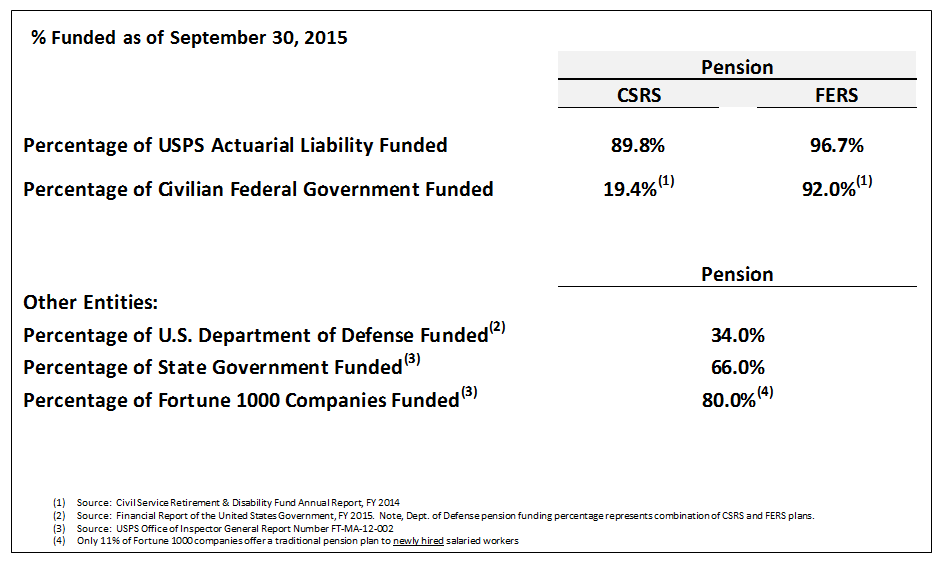
RETIREE HEALTH BENEFITS
Our significant financial losses are due in large part to the legally mandated RHB prefunding requirement. Such a requirement to prefund retiree health care obligations is not imposed on most other federal entities or private-sector businesses that offer retiree health benefits, let alone on an accelerated basis. The Postal Service’s funded level for RHB far exceeds that of civilian federal government entities, state governments, and private sector companies that even offer retiree health benefits.
USPS Retirement Liabilities Funding Compares Favorably to Other Entities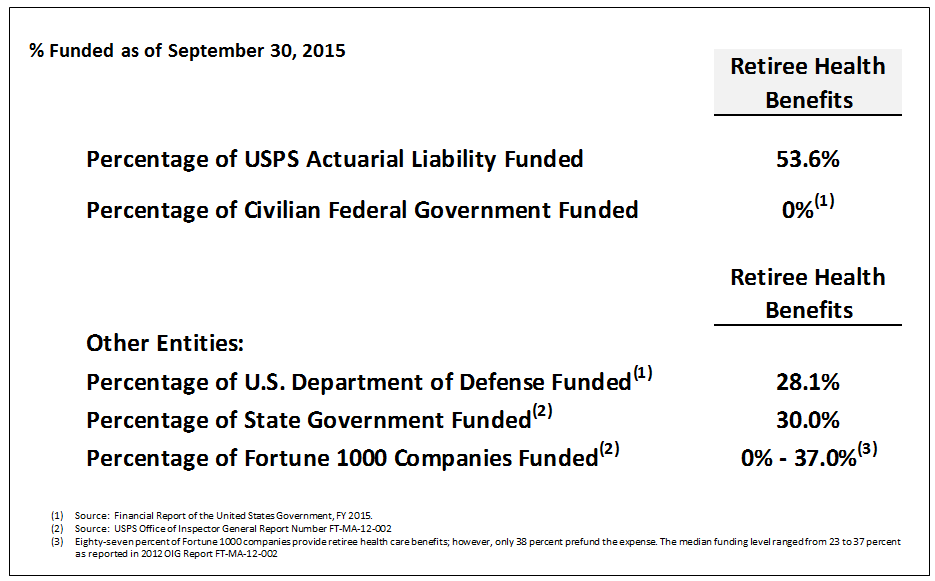
More importantly, even after the fixed RHB payments end and are replaced with actuarial payments, our RHB obligations under the FEHBP are simply unaffordable because we cannot require full integration with Medicare for all postal retirees. Our proposal requires OPM to create separately rated postal plans within the FEHBP, beginning with the 2017 contract year, which would be fully integrated with Medicare Parts A, B, and D. These plans would be offered by any existing FEHBP carrier that currently covers at least 1,500 postal employees and annuitants, and other carriers that desire to participate.
The proposal requires OPM to calculate the RHB actuarial liability on the basis of annuitant net claims costs, rather than premiums, in accordance with standard actuarial practice. It cancels the fixed prefunding schedule established in PAEA, and instead requires the Postal Service to make actuarially-based RHB prefunding payments. Each year, the Postal Service would make a normal cost payment, except to the extent that such a payment would cause the RHB actuarial liability to be more than 100 percent funded. In addition, the Postal Service would be required to amortize any unfunded RHB liability, predicated on an 80 percent funding target. The proposal further requires that a portion of the existing assets in the PSRHBF be invested in a manner designed to replicate the performance of the longest-term L Fund in the Thrift Savings Plan.
Opponents of this provision have argued that it would simply shift cost from the Postal Service to Medicare. While it is true that Medicare costs will increase by approximately $821 million per year, this provision is actually reversing the cost shifting that currently exists from Medicare to the FEHBP plans, ultimately imposing additional costs on the Postal Service, on our ratepayers, and on our employees. Since 1983, the Postal Service and its employees have been the second largest contributor to Medicare, contributing over $29 billion during this period. At present, however, 9 percent of eligible annuitants and dependents do not participate in Medicare Part A and 27 percent do not participate in Part B. More appropriately assigning claims costs to Medicare, instead of FEHBP, creates savings for the Postal Service and participants, and effectively resolves the RHB funding issue. Requiring full participation in Medicare by eligible annuitants is a universal practice among nearly all private sector and state and local government employers who provide health benefits to retirees. The Postal Service is simply asking to be treated like any other entity that is required to self-fund the benefits they offer to their retirees.
In addition, the overall impact to Medicare is relatively modest. To illustrate this point, total Medicare benefit payments to all recipients in FY 2016 are projected to be $684 billion, or $1.88 billion per day. The increased cost to the Medicare Trust Funds from the Medicare integration we are proposing represents less than half a day’s claims under the Medicare program. The integration cost of $821 million in FY 2016 is just one-tenth of 1 percent (0.1%) of the total annual Medicare payments.
The requirement for all retirees and survivors over age 65 to participate in Medicare Parts A and B — plus the additional Part D savings resulting from establishing an Employer Group Waiver Plan (EGWP) to take advantage of subsidies available for prescription drug benefits within each FEHB plan — would essentially eliminate 94 percent (or $54 billion) of the Postal Service’s unfunded retiree health benefit liability and reduce expenses by $38 billion over the next 10 years (2016-2025).
MARKET-DOMINANT RATES
The restoration of the exigent price surcharge is critical to the Postal Service’s financial health. The PRC-ordered rollback of the surcharge occurred on April 10, 2016, and will reduce our revenue and net income by approximately $1 billion this year and $2 billion per year going forward, which is an irrational outcome considering the Postal Service’s financial condition.
The price cap that is currently imposed on market-dominant products and services is clearly not enabling the Postal Service to achieve financial stability despite the best efforts of the Postal Service to reduce costs. In fact, the current price cap simply will not work since mail volumes have rapidly declined, while the costs necessary to maintain our network are largely fixed or are growing. Even the rapid growth experienced in the past few years in package volume is not enough to offset the decline in revenues from market-dominant products. The exigent surcharge softened the financial blow that the Postal Service suffered as a result of the massive loss of mail volume, and is the principal reason we achieved controllable income over the last two fiscal years (although we still suffered net losses in each of those years in excess of $5 billion).
The Postal Service proposal reinstates the 4.3 percent exigent increase and makes it a part of the rate base. The Postal Service would be prohibited from raising market-dominant rates until January 1, 2018, following the PRC’s review of the market-dominant regulatory system, as required by PAEA. This review should begin upon enactment of legislation and be completed by March 31, 2017, to allow both the Postal Service and the industry time to prepare for a January 1, 2018, price change.
PRODUCT FLEXIBILITY
Our proposal authorizes the Postal Service to provide non-postal services to state, local and tribal governments, as well as new, commercial non-postal services, so long as the PRC concludes that the provision of such services is consistent with a number of requirements. Specifically, any such non-postal service must be consistent with the public interest, must not create unfair competition with the private sector, must not unreasonably interfere with the value of postal services, must be undertaken in accordance with all federal laws and regulations applicable to the provision of such services, and must be reasonably expected to improve the net financial position of the Postal Service.
Our proposal also authorizes the mailing of beer, wine, and distilled spirits under specific conditions. The mailing must comply with all laws that govern the private shipments of alcoholic beverages at both the place of mailing and place of delivery, and delivery can only be made to an adult at least 21 years of age who provides a signature and valid identification. The proposal clarifies that it does not preempt any state, local, or tribal law that prohibits or regulates the delivery, shipment, or sale of beer, wine, and distilled spirits, so long as that law does not discriminate against shipment by the Postal Service relative to private carriers.
FINANCIAL IMPACT
As we’ve said, there is a way forward. The chart below shows the value of each of the parts making up our proposal, with total savings of $32 billion over the next five years. Enacting these key concepts into law will put the Postal Service on a more stable financial footing, allowing for further innovation, investments, and growth for the Postal Service, and the mailing industry as a whole.
USPS LEGISLATIVE PROPOSAL
With Medicare Integration Parts A, B and D
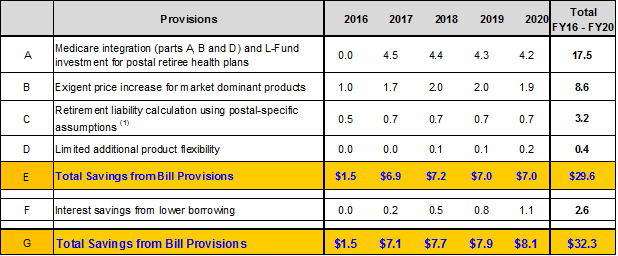
(1) “Postal-specific assumptions” include the reduction in the annual CSRS and FERS amortization payments resulting from lengthening the amortization period to 40 years and the refunding of the FERS surplus
Note: Totals may not add up due to rounding
CONCLUSION
Mr. Chairman, the United States Postal Service delivers for the American public — both literally and figuratively. We serve every American business and residence. We do so reliably and affordably, and we strive continually to earn the trust of the American public by maintaining the privacy and security of the items we deliver. We enable America’s commerce by meeting its marketing and communications needs, by delivering the physical content that powers e‑commerce, and by serving as an indispensable business partner to America’s entrepreneurs and business owners.
America deserves a financially stable Postal Service that can continue to play this vital role in our economy and society. In a dynamic and increasingly digital, mobile and device-driven world, the Postal Service has opportunities to enhance the way we enable commerce. However, we require the financial ability to invest in the Postal Service’s future.
We have presented a path forward that depends upon the passage of a set of legislative provisions. Once enacted, and together with our other initiatives, the Postal Service can meet all of our obligations and improve the way we serve the American public.
Thank you, Mr. Chairman, for the opportunity to submit this testimony. I welcome any questions that you and the committee may have.
